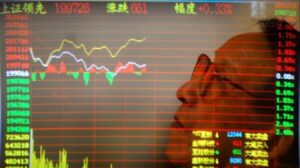
German Chancellor Olaf Scholz and President of the European Commission have proposed launching a new “Marshall Plan” for the post-war reconstruction of Ukraine.
This is stated in a joint article published in the Frankfurter Allgemeine newspaper.
“We are already thinking about rebuilding the country, even if peace still seems far away. Ukraine needs the prospect that it will be able to grow economically again as soon as the war is over,” the article says.
In their opinion, neither Ukraine nor individual partners are able to cope with the damage received on their own, since the preliminary amount reaches at least 350 billion euros. In this regard, Scholz and von der Leyen proposed launching an “inclusive donor platform” that would allow more transparent allocation of funds to restore the destruction in Ukraine.

Oil prices fall on Monday, despite rising energy demand in China.
The pressure on the market continues to be exerted by the strengthening of the dollar, as well as fears of a recession in the global economy as a result of the rapid tightening of monetary policy by world central banks, Bloomberg notes.
“The high volatility of the oil market will continue as we see both the risks of a recession and the possibility of a supply shortage,” said Zhaojin Futures Co. analyst. Gao Jian.
The cost of December futures for Brent on the London ICE Futures exchange by 8:15 Moscow time on Monday is $92.87 per barrel, which is $0.63 (0.67%) lower than the closing price of the previous session. As a result of trading on Friday, these contracts rose by $1.12 (1.2%) to $93.5 per barrel.
The price of futures for WTI oil for December in electronic trading on the New York Mercantile Exchange (NYMEX) fell by $0.6 (0.71%) by this time, to $84.45 per barrel. By the close of previous trading, the value of these contracts increased by $0.54 (0.6%) to $85.05 per barrel.
As a result of last week, Brent rose by 2%, WTI – by 0.5%.
Statistical data on the Chinese economy, published on Monday, showed a more significant than expected growth in the country’s GDP in the third quarter. The indicator increased by 3.9% in annual terms after rising by 0.4% in the previous quarter. The consensus forecast of experts polled by Trading Economics called for growth of 3.4%.
The growth rate of Chinese exports in September slowed down to 5.7% from 7.1% in August, while imports grew by 0.3%, the same as a month earlier.
At the same time, China’s oil imports increased to 9.83 million barrels per day, the highest since May, according to Bloomberg calculations based on data from the General Administration of Customs of the People’s Republic of China.

Asian stock indices started the working week without any dynamics, while the stock markets of mainland China and Hong Kong went negative on the statistics.
China’s economy expanded 3.9% in the third quarter compared to the same period last year, the State Bureau of Statistics (GSO) said. Thus, the growth rate accelerated significantly compared to 0.4% in April-June. Analysts on average expected an increase of 3.4-3.5%.
China’s GDP in January-September increased by 3%. This is significantly below the target set by the authorities of the country as a whole for 2022 at the level of about 5.5%, experts say.
Retail sales in the country in September increased by 2.5% compared to the same month a year earlier, the CSO also reported. This is the minimum rate of recovery over the past four months. The consensus forecast assumed growth of 3.3%.
China’s foreign trade surplus widened unexpectedly in September, as import growth was significantly weaker than exports. Imports increased by only 0.3% in annual terms, exports grew by 5.7%. Analysts polled by The Wall Street Journal, on average, predicted the growth of the first indicator by 1%, the second – by 4%.
The Chinese Shanghai Composite index decreased by 1.2% by 08:37 Moscow time. Hong Kong’s Hang Seng plunged 5.4% to its lowest in more than thirteen years.
Shares of Internet companies Meituan (SPB: 3690) (-12.4%), Baidu Inc. (SPB: BIDU) (-10.7%) and Tencent (SPB: 700) Holdings Ltd. (-9.2%), as well as the developer Longfor Group Holdings Ltd. (-12.2%).
Retailers Alibaba Group (SPB: BABA) and JD.com Inc. (SPB: JD) lost 10.4% and 11%, respectively.
Among the components of Hang Seng, only six stocks show an increase in value, including HSBC bank (+0.5%), developer CK Infrastructure Holdings Ltd. (+3.4%) and electrical equipment manufacturer Techtronic Industries Co. (+1.1%).
The value of the Japanese Nikkei 225 increased by 0.5% by 08:33 Moscow time.
The stocks of the transport companies Kawasaki Kisen Kaisha Ltd. have risen most significantly. (+4.4%), Mitsui O.S.K. lines ltd. (+4.2%) and Nippon Yusen K.K. (+3.7%), as well as non-ferrous metal producer Sumitomo Metal Mining Co. (+4.1%).
The South Korean Kospi index added 0.9% by 08:30 Moscow time.
Quotes of securities of one of the world’s largest manufacturers of chips and electronics Samsung Electronics Co. rise by 2.7%, while the cost of automaker Hyundai Motor fell by a similar amount.
The Australian S&P/ASX 200 rose 1.5%.
The capitalization of the world’s largest mining companies BHP and Rio Tinto increased by 2.6% and 1.2%, respectively.
In addition, shares of all four largest banks in the country fell in price: Commonwealth Bank – by 1.2%, ANZ Bank – by 0.2%, Westpac Banking – by 0.6% and National Australia Bank – by 0.7%.

The US dollar is weakly strengthening against the euro at auction on Monday, depreciating against the pound sterling.
The yen against the dollar, which jumped at the beginning of the session, again moved to the decline.
The ICE-calculated index showing the dynamics of the dollar against six currencies (the euro, the Swiss franc, the yen, the Canadian dollar, the pound sterling and the Swedish krona) adds less than 0.1%, the broader WSJ Dollar Index – 0.25%.
The euro/dollar pair is trading at $0.9855 as of 9:15 p.m. compared to $0.9864 at the market close on Friday
The pound sterling has risen in price by this time to $1.1375 in comparison with $1.1304 following the results of the previous auctions. The pound strengthens after the refusal of former British Prime Minister Boris Johnson to fight for the post of leader of the Conservative Party and, accordingly, the head of the British government.
This gives ex-Finance Minister Rishi Sunak a good chance of winning, the Financial Times notes.
The dollar/yen pair was trading at 148.93 yen as of 9:15 a.m. versus 147.68 yen at market close on Friday. At the beginning of the session, the dollar fell to 145.53 yen, but then again turned to growth.
On Friday, the US currency fell 0.72% against the yen, which the Nikkei newspaper attributed to the intervention of the Japanese authorities in the foreign exchange market.
Japan’s Finance Minister Shun’ichi Suzuki said on Monday that the Japanese government would take the necessary measures to prevent “excessive exchange rate fluctuations.”
He declined to say whether there were interventions on Friday and Monday.
The dollar against the yen on Friday rose to 151.94 yen – the highest since July 1990.
The dollar against the yuan edged up to 7.2535 yuan from 7.2438 yuan despite stronger than expected Chinese GDP data.
China’s GDP in the third quarter increased by 3.9% in annual terms after rising by 0.4% in April-June. The consensus forecast of experts polled by Trading Economics called for growth of 3.4%.

Ex-Prime Minister of Great Britain Boris Johnson said that he was not going to run for office because he would not be able to effectively govern the state in the absence of a united party in parliament.
“I passed the very high barrier of 102 support votes, but I came to the conclusion that this is simply not the right time,” Johnson was quoted as saying by Sky News.
He added that he had contacted Rishi Sunak and Penny Mordaunt with an offer to “unite in the national interest.” Johnson also noted that he does not exclude the possibility of his return to big politics.
At the moment, among the Conservative MPs, Sunaka is in the lead with 144 supporters. It is noted that on Sunday several longtime allies of Johnson, including Swell Braverman and Steve Baker, supported Sunak.

DTEK Kyiv Grids announced the cancellation of stabilization power outages in Kyiv by Sunday morning.
DTEK Kyiv Electric Grids returned electricity to all consumers who were subjected to stabilization blackouts by order of NPC Ukrenergo from 09:20 on October 22 to 00:36 on October 23. All houses in Kyiv with light,” the company said on its website on Sunday.
For his part, Serhiy Kovalenko, CEO of the energy supplier YASNO, on his Facebook, among other things, announced the cancellation of shutdowns in Kyiv.
“End energy alarm in Kyiv,” he wrote, advising to keep an eye on the company’s announcements to have time to prepare for possible outages.
DTEK Kyiv Regional Electric Grids and DTEK Donetsk Grids also reported that by Sunday morning all their clients, to whom stabilization restrictions were applied by order of Ukrenergo, also had electricity due to their cancellation.
On Sunday morning, the head of the Rivne OVA, Vitaliy Koval, said that during the night, power engineers managed to connect most of the subscribers to the power supply, to whom it was limited due to Russian attacks on the power system. “Now we are working on connecting another 24,750 subscribers. These are, in particular, residents of the village of Zarya, Alexandria, Klevan, Orzhei, Shpanov, Shubkov and others,” he wrote on his Facebook.
At the same time, all publications continue to call on Ukrainians, both the population and businesses, to save electricity as much as possible and not create additional load on the networks during peak hours.
As reported, as a result of damage to the energy infrastructure of Ukraine as a result of the morning large-scale air attacks of Russian troops on October 22, NPC Ukrenergo was forced to impose power supply restrictions in Kyiv and ten regions. According to the company, the scale of destruction on that day is comparable to or greater than that inflicted on the energy system on October 10-12. Earlier, Energy Minister German Galushchenko said that Russian air attacks on energy systems, which have intensified since October 10, have damaged 30-40% of the total national energy infrastructure. According to his calculations, approximately half of the thermal generation capacity was damaged, due to which Ukraine lost 4,000 MW of capacity.